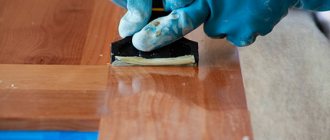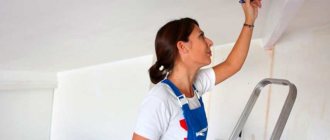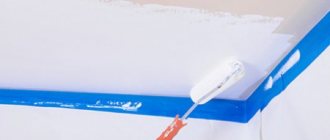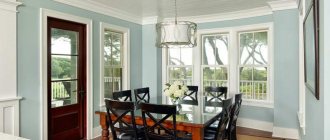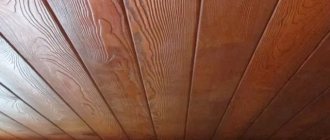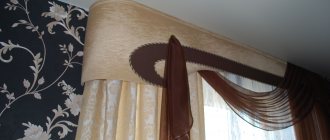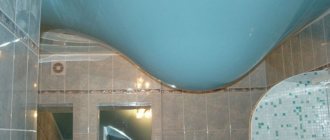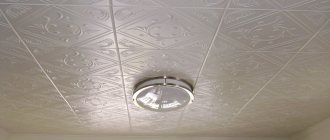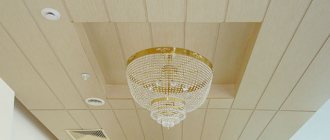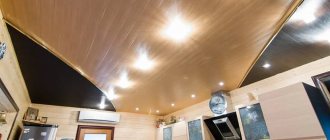Contrary to all forecasts, the classic whitewashing of the ceiling surface has not sunk into oblivion, and is still actively used today. You can understand this choice: fast, inexpensive and at the same time quite reliable and attractive. However, among those who practice this method of decorating the top of a room, a reasonable question invariably arises: is it possible to whitewash the ceiling using old whitewash? The motive for such manipulations is more than transparent: to reduce all the time spent on decorating the ceiling surface to a minimum. Read below about how this is done.
- Exceptions;
- What you will need;
- Which material to choose? Current prices for chalk and lime;
- Preparing the premises;
- Ceiling preparation;
- Preparation of the solution;
- Whitewashing process;
- Conclusion.
Materials for whitewashing the ceiling surface
First of all, you need to decide how to whitewash the ceiling in your apartment by choosing one of the options. Each of them has advantages and disadvantages.
It could be:
- lime;
- chalk;
- water-based paint.
As for such a material for whitewashing the ceiling as chalk, it will give the repaired surface a radiant whiteness. Even though the room will look good, it will create additional dust. This is explained by the fact that the chalk will gradually begin to crumble. Also, this material is not waterproof, so it is not suitable for repairing the ceiling in the bathroom.
Whitewashing using lime is an excellent way to combat fungus. In the rooms where it appeared, this should be used. In addition, lime on the ceiling is resistant to high humidity. It can be used to paint the ceiling surface in any room, including the bathroom. Lime whitewash successfully hides minor defects such as cracks and cracks.
Before whitening the ceiling with lime, you should take into account the fact that this material can cause an allergic reaction. Also, the surface is not perfectly snow-white, unlike a chalk-based composition.
After applying water-based paint, the ceiling has an excellent appearance; it adheres well to the previous coating. The composition adheres to old whitewash and does not begin to peel off over time. This paint has the only drawback - when using it, repairs can be carried out at temperatures from +5°C. But when painting the ceiling is done indoors, this circumstance does not matter.
If you do not want to wash off the previous layer from the surface, then you should know that whitewashing the ceiling using old whitewash has a number of nuances. The fact is that chalk cannot be applied to lime, and vice versa, otherwise the new layer of finishing will not fit well, resulting in dirty stains appearing on the ceiling surface.
It is permissible to apply the same layer or water-based paint on top of the chalk solution. If the old whitewash on the ceiling was lime-based, it can only be covered with the same material or an emulsion coloring composition. In addition, you need to take into account that enamels or oil paints are not applied to the old chalk or lime layer.
Exceptions
Put a new layer on top of the old one - what could be simpler? Perhaps the apparent simplicity is what attracts property owners who have started a renovation and quite naturally want to complete it as quickly as possible with the best possible result. However, there are exceptions to any rule, and first we will touch on those conditions under which this cannot be done:
- if the old layer is made of lime and there is shedding of the layer;
- there are damage, swelling and noticeable irregularities;
- there are traces of mold or large stains;
- the base layer differs in thickness.
Don’t be scared and critically examine your ceiling for the presence of all of the above - in most cases, simplification is still feasible and brings a fairly pleasant result. Just take a look at the ceiling surface and determine whether its shortcomings are so obvious? You need to understand that new whitewash over the old one performs only the function of cosmetic repairs and is not capable of correcting defects in the base surface.
Tools for whitewashing
Before whitewashing the ceilings yourself, prepare the necessary tools - this work is performed in one of three ways, for which they are used:
- roller;
- sprayer, also known as a spray gun;
- brush.
If painting is carried out with a roller, then the coloring composition will lie in an even layer, without forming spots or streaks. To get a good result, whitewash is applied in two layers. You will need to have not only a roller, but also a container for the solution, a mixing tool, a paint tray and a small brush for applying paint where the ceiling meets the wall.
A whitewash brush can be purchased at any building materials store at an affordable price. When using it, the composition splashes, so you should protect the furnishings in the room from it and use special eye glasses.
The use of a sprayer allows you to lay the whitewash in an even, neat layer. Using a spray gun to whitewash the ceiling, you will reduce the time it takes to complete the work. When using paint, make sure it is free of lumps. Its consistency should be more liquid compared to whitewash, which is applied with a roller or brush.
How to prepare for whitewashing correctly
Before starting work, it is necessary to ensure protection of hands, eyes and respiratory tract (prepare goggles, respirator and rubber gloves ). This is very important, since whitewash particles entering the body can provoke allergy attacks.
Furniture is removed from the room, or anything that could not be gotten rid of, and the floor is covered with polyethylene or thick canvas.
Attention: during the whitewashing process, the windows in the room must be closed, otherwise streaks may appear on the renewed surface.
The surface of the flow is inspected for the presence of cracks and chips, all irregularities are puttied and rubbed with sandpaper.
The cleaned, prepared surface is thoroughly primed, after which you can proceed directly to applying new whitewash.
The main question is: how can you cover a ceiling that has already been painted with lime whitewash? The answer is simple - new lime mortar. It's not difficult to prepare. It is enough to mix 2 kg of dry lime, 1 tsp in a clean container. blue and 10 gr. salt (pre-mixed in water), 10 liters of water.
It is easy to check the desired consistency of the prepared solution. To do this, lower a knife into the whitewash, and if the solution does not drain from the blade, then you can safely get to work.
Algorithm of actions:
- Whitewash is poured into the tray.
- The roller is dipped into the paint, rolled out slightly onto the tray and begins to paint.
- The strokes are perpendicular to the window
- After the first layer is applied, the second is applied.
- The joints with the wall are carefully painted with a brush.
An accelerated option is to whitewash the ceiling using a spray gun. The process has its own characteristics:
- The solution should be more viscous than for a roller or brush.
- The whitewash is filtered through a sieve before being poured into the spray gun.
- Using a spray gun, the ceiling is whitewashed in three or four layers.
Choosing water-based paint
If, when deciding on the best option to whiten the ceiling, you decide to use this type of paint, then you need to take into account that there are many varieties of them, they differ in composition and properties:
- Polyvinyl acetate paints. They are the most affordable.
- Water-based emulsions with acrylic additives. They are the most popular. They are used for different surfaces, they are resistant to abrasion, but for ceilings this does not matter.
- Silicone paints. If the ceiling whitewash is being repaired, it can be done without using a primer. This painting composition is distinguished by a high degree of vapor permeability; it is suitable for painting ceiling surfaces in the kitchen or bathroom. This paint can reliably protect the ceiling from fungus.
- Water emulsions with latex. They have excellent water resistance; surfaces painted with them can be washed with detergents. Such compositions are the most expensive among similar products.
To decide which whitewash is best for the ceiling, before purchasing water-based paint, you need to carefully read the label, which indicates the purpose of the composition, consumption per “square” of area and other important information.
A correctly selected composition allows you to create a durable snow-white ceiling covering - it will not turn yellow over time and will be reliably protected from the appearance of fungus.
Whitewashing using water-based paint
Before whitening ceilings by applying a water-based emulsion over lime, the previous layer should first be coated with an acrylic primer. Then it doesn’t hurt to make sure the surface is durable; to do this, you can try to scratch it.
Paint is applied only when the ceiling is not crumbling. When painting over chalk, there is no need to do any preparation. The water-based composition will adhere to the ceiling without the use of a primer.
Before starting renovations, you should prepare the room. Objects in it are carefully covered with film or taken out of the room to protect them from paint.
When applying the coloring composition with a brush, first the strokes are placed perpendicular to the windows, and then parallel to them. If the final layer is parallel to the light source, there will be no noticeable streaks after the paint dries.
Preparing the premises
- remove all small-sized furniture from the room, and securely cover what cannot be removed with plastic wrap along with the floor;
- you should clear the room of furniture so that you have room to maneuver;
- Close the door to the room tightly, as well as all the windows, otherwise you risk causing streaks to appear on the ceiling that has not yet dried.
Repair with chalk
Before you make a ceiling with whitewash, you should prepare a chalk solution, for which 10 liters will require 50 grams of wood glue and 5 kilograms of chalk. Its consistency should be such that the composition does not drain from the knife. If this is not the case, add chalk. You can add blue to the mixture to make the surface snow-white, without yellowness.
The technology for repairing a ceiling with chalk is no different from the process of applying water-based paint. First, choose a repair tool - a brush, roller or sprayer. The composition should lie in an even layer.
Quite popular today is adhesive whitewashing of the ceiling, which contains glue; it is much easier to apply and holds more firmly. If a surface covered with simple chalk can stain your hands upon contact, then adhesive painting has no such disadvantages. In addition, this whitewash can be given any color shade.
Lime whitewash
To prepare a lime mortar for painting the ceiling surface, take 2.5 kilograms of lime, add 100 grams of salt, pre-soaked in water, and also a little blue. All components are mixed, and water is poured in so that the resulting volume of the mixture is approximately 10 liters.
The rules for how to whitewash a ceiling with lime are similar to the recommendations for how to apply water-based paint and chalk mortar.
Using water emulsion
Having asked the question of how to whitewash a ceiling using old whitewash, you should, of course, decide on the type of finish used. Chalk and lime are used extremely rarely today when decorating ceilings. In most cases, apartment and house owners use water-based paint. This product is applied to the ceiling surface much more evenly. In addition, the water-based emulsion does not peel off over time. But of course, such a finish will last a long time only if it is applied correctly.
Before painting with water-based paint, the bleached ceiling should be primed. In this case, a special deep penetration agent should be used. After the primer has dried, you need to test the old coating for strength. To do this, just try to scratch the ceiling with a spatula. If the old coating is easily removed, it is better not to risk it and remove it anyway. If the chalk or lime soaked in primer holds tightly, you can start painting.
Sometimes owners of apartments and houses finish whitewashed ceilings with water-based emulsion and without prior priming. This is also acceptable. But only if very high-quality paint from a good manufacturer is used.
[custom_ads_shortcode3]
Important nuances
When repairing the ceiling surface, you should take into account the purpose of the room. For example, if this is a bathroom, it requires the use of a special composition that is resistant to high humidity and can protect the ceiling from fungus. Otherwise, the paint will lose its attractive appearance within a short time and, most likely, will begin to crumble.
When performing painting work, it is necessary to remember safety, since the whitewash must not come into contact with the respiratory system, eyes or skin. To do this, use a respirator, rubber gloves and special glasses. The fact is that the coloring composition can cause serious allergic reactions, and sometimes chemical burns.
Expert advice
Advice from professional craftsmen will help you get the job done quickly and correctly:
- Do not apply a second coat of whitewash until the first has dried. Otherwise, unsightly drops and sagging will form. The same will happen when applying the whitewash composition in a thick layer.
- To prevent the whitewash from crumbling, do not allow drafts in the room or direct sunlight to reach the surface while it is drying.
- While working, use protective equipment (glasses, gloves and a hat).
If you calculate the costs of whitewashing the ceiling surface, they will be minimal compared to the cost of a suspended or stretch ceiling. In addition, the bleached ceiling is considered an environmentally friendly coating, which is suitable for children's rooms and rooms where allergy sufferers live.
Removing old whitewash from the ceiling
Despite the fact that there is a technology for how to whiten a ceiling with your own hands without washing off the previous layer, to obtain a high-quality result you need to clean the surface and be sure to level it.
You should definitely wash off the previously applied whitewash that does not adhere well to the ceiling. If it is not removed, you cannot expect a decent result. When the chalk or lime layer is smooth, thin and firmly in place, painting can be done over it.
If you still need to prepare the ceiling for whitewashing, proceed as follows to remove the chalk:
- The foam sponge is moistened in water so that it becomes damp and drops do not drip from it.
- They pass it over the surface over and over again, thereby washing off layer by layer, wetting it as often as possible.
- Finally, wipe the ceiling with a wet cloth, frequently dipping it in water.
As for the lime layer, it is much more difficult to remove:
- First of all, moisten the entire ceiling surface, for which you can use a spray bottle.
- The soaked material is removed with a scraper or spatula.
- Then thoroughly wash the ceiling with a sponge or rag to remove any remaining dust and lime.
It is better to work in sections: while the soaked lime is removed from one of them, the surface of the other absorbs moisture. As a result, you can prepare the ceiling faster. Also, special means are used to wash off the previous whitewash.
Building materials stores sell a remover that is applied by spray. After it dries, a crust forms on the ceiling; it must be removed with a scraper. Finally, wash the surface with a rag.
There is another option for deleting the old layer. Vinegar is added to the water in the amount of one tablespoon per 5 liters and 50 milliliters of bath foam. The components are thoroughly mixed and applied to the ceiling. After 20 minutes, it is cleaned with a scraper and wiped with a wet cloth.
There is another way to clean old whitewash. You need to mix water and flour. The resulting paste is applied to the surface and allowed to dry, after which removing the old layer is not difficult.
Is it worth finishing the surface without pre-cleaning?
So, we found out whether it is possible to whitewash the ceiling using old whitewash. In principle, this is allowed. If all the recommendations listed above are followed, the owner of an apartment or house can ultimately obtain a fairly even and beautiful coating. However, unfortunately, such finishing will have to be corrected in the future sooner than if the ceiling had been previously cleaned.
Therefore, before deciding to whitewash without removing the old layer, you should think carefully. The lime sticks to the ceiling quite firmly. Therefore, if the surface is finished with it, applying a new layer without removing the old ones still makes some sense. But chalk can be removed from the ceiling very easily - just with a rag and water. Therefore, in this case, it is more advisable to pre-clean the surface.
Professional ceiling painting
If you do not have enough skills and knowledge on how to properly whitewash ceilings, you can use the services of professionals. This solution has many advantages. It allows you not only to save time, but also to get excellent results. A professional will use a minimum amount of paint to whitewash the ceiling, so the repair will not cost much more than painting it yourself. The main thing you should pay attention to is the skill of those who are to be hired.
It must be remembered that whitewashing old paint is an inexpensive and simple way to transform the interior of a room for the better. It should not always be used and only when the previous layer is even and holds up perfectly. In this case, water-based paint, lime, and chalk applied directly to the old base will adhere reliably.
Whitewashing is not difficult. You need to turn to experts for help and hire professionals in order to save time if the owner of the premises is a busy person and does not have the opportunity to carry out repairs.
